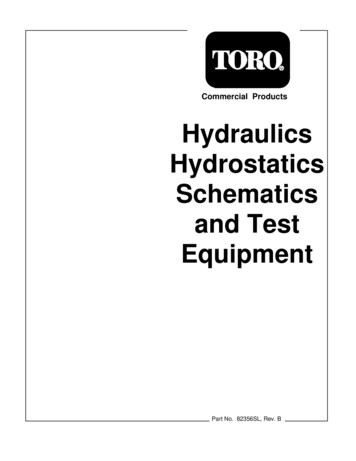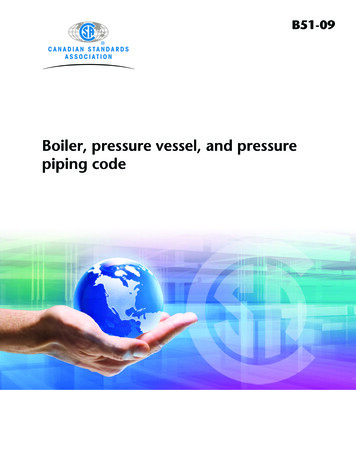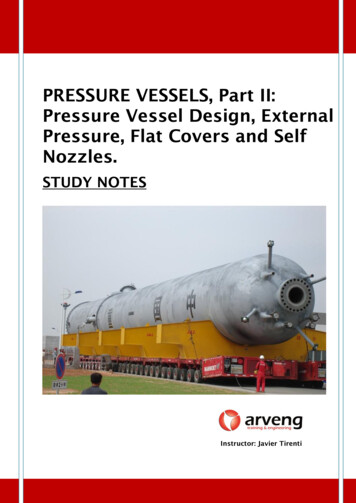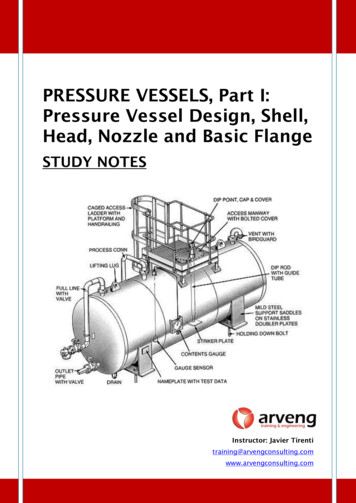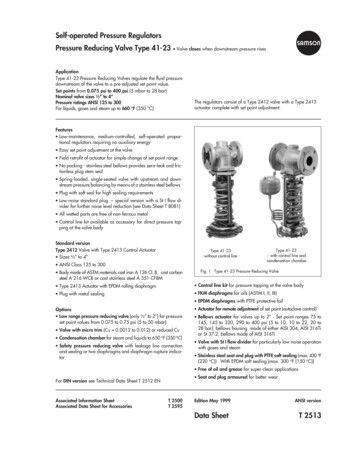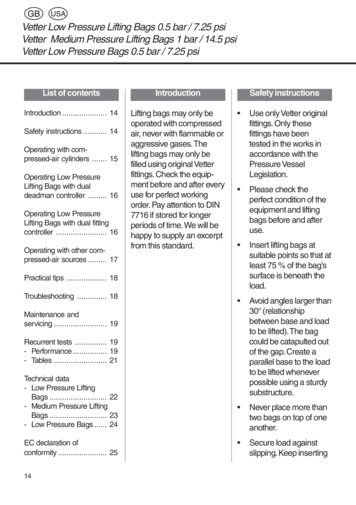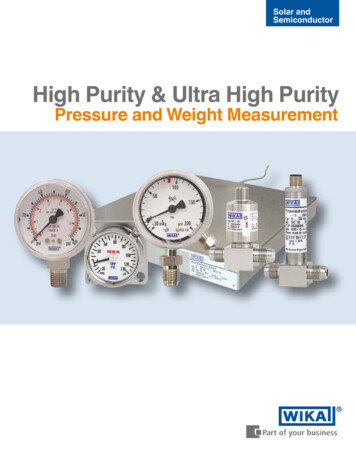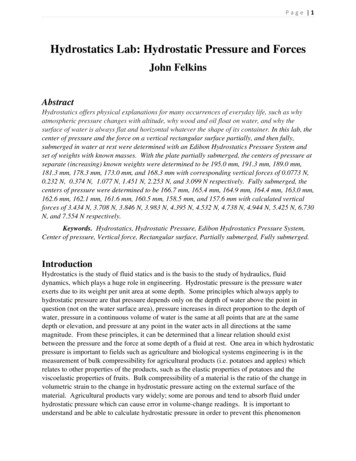
Transcription
Page 1Hydrostatics Lab: Hydrostatic Pressure and ForcesJohn FelkinsAbstractHydrostatics offers physical explanations for many occurrences of everyday life, such as whyatmospheric pressure changes with altitude, why wood and oil float on water, and why thesurface of water is always flat and horizontal whatever the shape of its container. In this lab, thecenter of pressure and the force on a vertical rectangular surface partially, and then fully,submerged in water at rest were determined with an Edibon Hydrostatics Pressure System andset of weights with known masses. With the plate partially submerged, the centers of pressure atseparate (increasing) known weights were determined to be 195.0 mm, 191.3 mm, 189.0 mm,181.3 mm, 178.3 mm, 173.0 mm, and 168.3 mm with corresponding vertical forces of 0.0773 N,0.232 N, 0.374 N, 1.077 N, 1.451 N, 2.253 N, and 3.099 N respectively. Fully submerged, thecenters of pressure were determined to be 166.7 mm, 165.4 mm, 164.9 mm, 164.4 mm, 163.0 mm,162.6 mm, 162.1 mm, 161.6 mm, 160.5 mm, 158.5 mm, and 157.6 mm with calculated verticalforces of 3.434 N, 3.708 N, 3.846 N, 3.983 N, 4.395 N, 4.532 N, 4.738 N, 4.944 N, 5.425 N, 6.730N, and 7.554 N respectively.Keywords. Hydrostatics, Hydrostatic Pressure, Edibon Hydrostatics Pressure System,Center of pressure, Vertical force, Rectangular surface, Partially submerged, Fully submerged.IntroductionHydrostatics is the study of fluid statics and is the basis to the study of hydraulics, fluiddynamics, which plays a huge role in engineering. Hydrostatic pressure is the pressure waterexerts due to its weight per unit area at some depth. Some principles which always apply tohydrostatic pressure are that pressure depends only on the depth of water above the point inquestion (not on the water surface area), pressure increases in direct proportion to the depth ofwater, pressure in a continuous volume of water is the same at all points that are at the samedepth or elevation, and pressure at any point in the water acts in all directions at the samemagnitude. From these principles, it can be determined that a linear relation should existbetween the pressure and the force at some depth of a fluid at rest. One area in which hydrostaticpressure is important to fields such as agriculture and biological systems engineering is in themeasurement of bulk compressibility for agricultural products (i.e. potatoes and apples) whichrelates to other properties of the products, such as the elastic properties of potatoes and theviscoelastic properties of fruits. Bulk compressibility of a material is the ratio of the change involumetric strain to the change in hydrostatic pressure acting on the external surface of thematerial. Agricultural products vary widely; some are porous and tend to absorb fluid underhydrostatic pressure which can cause error in volume-change readings. It is important tounderstand and be able to calculate hydrostatic pressure in order to prevent this phenomenon
Page 2from occurring when attempting to measure bulk compressibility (Chen et al., 1977). Thetomato and other such fruits have an external skin and internal solid and liquid material assumedto be viscoelastic; the internal portion is free to exert hydrostatic pressure on the skin as stressesare applied externally. Thus, it was concluded that a test providing stress from hydrostaticpressure would give a realistic evaluation of skin deformation and strength properties for suchfruits (Allen et al., 1974). Hydrostatics is also the basis for the study of hydraulics, which areused every day in automobiles, farm equipment, construction equipment, lifting equipment.These are just some of the applications of hydrostatics in the natural world.ObjectivesThe objectives of this lab where for students to (1) become familiar with hydrostatic pressuresystem, (2) measure center of pressure and force on a vertical rectangular surface when thesurface is partially submerged, then fully submerged, in a liquid at rest, (3) plot required graphs,and (4) be able to calculate the center of pressure and hydrostatic force from obtained data ofknown mass of weights and height of fluid at rest.Methods and MaterialsThe Edibon Hydrostatic Pressure System module used in this lab consists on a quadrantassembled on the arm of a scale that swings around an axis. When the quadrant was introducedin the tank of water, the force that acted on the front rectangular surface exercised a moment withregard to the supporting axis. The swinging arm had a pan and an adjustable counter balance, thetank had adjustable supporting legs that determine its proper levelling, and it had a drainagevalve. Figure 1 shows a photo of a hydrostatic pressure system and Figure 2 gives a diagram ofthe system. Figure 3 shows the submerged surface viewed from the left side of the tank inFigure 2. The depth of the centroid below the surface of the water is h. The x-y coordinatesystem has its origin at the centroid. The y-direction position of the center of pressure,𝑦𝑅 , is𝐼𝑦𝑅 𝑦𝑐 𝑦𝑥𝑐𝐴𝑐(1)Where 𝐼𝑥𝑐 is the moment of inertia of the surface about the x-axis, and A is the surface area.Buoyancy force is not neglected here. Buoyancy force is defined as the net pressure force actingon a submerged body. If we consider the pressure force components acting in the horizontal andvertical directions, then the buoyancy force contributes to the moment about the device pivot. Ifinstead we consider the pressure forces acting normal to the surface of the acrylic arc, then thebuoyancy force does not appear because the normal forces on the curved surface do notcontribute a moment about the pivot of the device. This is due to the circular arc shape of thedevices, because it allows us to measure the hydrostatic pressure forces without accounting forthe buoyancy effect. Consider the moment balance depicted in Figure 4. Only the forcecomponents normal to the surface are identified, no forces are neglected because the pressureforce acts normal to the surface. In this particular apparatus it is easier to analyze the normalforces directly than to separate the forces into horizontal and vertical components. The localpressure force on the curved surface of the acrylic is not zero. However, the pressure forces on
Page 3the curved surface do not contribute to moments about O because these forces have lines ofaction that pass directly through O; thus, the device eliminates the contributions of all surfaceforces except the force acting on the vertical surface . A moment balance about point O showsthat the moment F (H h) is balanced by WL.Figure 1: Hydrostatic Pressure SystemFigure 2: Hydrostatic Pressure System Diagram
Page 4Figure 3: Rectangular Surface (with nomenclature for locating center ofpressure)Figure 4: Hydrostatic Forces Normal to Curved Surface
Page 5Figure 5: Given Lab Equations.Results and DiscussionsFigures 6A- 6E are the plots for when the rectangular vertical surface is only partially submergedand Figures 7A-7E are the plots of the data for when the rectangular vertical surface is fullysubmerged.0.25R² 0.9999m (kg)0.20.150.10.05000.020.040.060.080.10.12y (m)Figure 6A: Counterweight Mass vs. Theoretical (Estimated) HeightUsing Eqn. 1, the theoretical height of the fluid (water) is estimated for Figure 6A. This figureshow the counterweight mass that corresponds to each certain theoretical height. These two setsof data show a power (non-linear) trend between the estimated height and its correspondingmass. As theoretical height increases, the change in counterweight mass changes exponentially.
Page 60.120.1R² 0.9999y (m)0.080.060.040.02000.050.10.150.20.25h (m)Figure 6B: Theoretical (Estimated) Height vs. Actual (Experimental) HeightFigure 6B plots the estimated height versus the experimental height. This figure shows that thereis a greater difference between the two data as each height increases. The greater the height ofthe water, the greater the difference between it and the corresponding theoretical height.0.20.195hp (m)0.190.1850.180.1750.17R² 10.16500.010.020.030.040.050.060.070.080.090.1h (m)Figure 6C: Center of Pressure vs. HeightFigure 6C shows that when the apparatus is not fully submerged, there is a linear relationbetween the center of pressure and the height. This relation is that as the height of the waterincreases in height, the center of pressure decreases in height.
Page 73.5R² 132.5F .1h (m)Figure 6D: Hydrostatic Force vs. HeightFigure 6D plots the hydrostatic force against the height of the water. It can be determined fromthis figure that as there is an increase in height there is also an exponentially related increase inthe hydrostatic force.2.52sd1.510.500102030405060708090100h (mm)Figure 6E: Standard Deviation vs. HeightFigure 6E shows the standard deviation between the theoretical height and the actual height ofthe water plotted against the actual height. This figure shows that as the height is increased, itsrelation to the standard deviation slowly becomes more linear.
Page 80.50.45R² 10.4m 0.120.140.160.18y (m)Figure 7A: Counterweight Mass vs. Theoretical (Estimated) HeightFigure 7A shows that there is a linear relation between the theoretical height and thecounterweight mass when the rectangular vertical surface is fully submerged unlike that of whenthe surface is only partially submerged.0.18R² 0.99850.160.14y 20.140.160.18h (m)Figure 7B: Theoretical (Estimated) Height vs. Experimental Height
Page 90.1680.166hp (m)0.1640.1620.160.158R² 60.18h (m)Figure 7C: Center of Pressure vs. Height8R² 176F (N)54321000.020.040.060.080.10.120.14h (m)Figure 7D: Hydrostatic Force vs. HeightWhen fully submerged, as with the other plots for the fully submerged surface figures, thehydrostatic force vs. height plot is linear.
P a g e 1043.53sd2.521.510.50020406080100120140160180h (mm)Figure 7E: Standard Deviation vs. heightThe standard deviation vs. height plot for the fully submerged surface is not as smooth as that ofthe partially submerged surface and fluctuates more in a smaller set of heights.The figures for the two situations (partially and fully submerged) provide a common trend thatwhen the vertical surface is only partially submerged there is a common exponential relationbetween data, and when the surface is fully submerged there is a common linear relation betweenthe data. This trend is related to the fact that the hydrostatic pressure and force on the surface isunevenly spread against the surface when it is only partially submerged and when it is fullysubmerged, only a force normal to the surface is of importance.Conclusions When a surface is only partially submerged in a fluid at rest; the height, counterweightmass, hydrostatic pressure, and hydrostatic forces are exponentially related.When a surface is completely submerged in a fluid at rest; the height, counterweightmass, hydrostatic pressure, and hydrostatic forces are linearly related and have a standarddeviation that fluctuates more than that of when the surface is only partially submerged.No matter whether the surface is fully submerged or only partially submerged; as actualheight increases so does the counterweight mass, theoretical height, and hydrostatic force.No matter whether the surface is fully or partially submerged, as the actual heightincreases, the center of pressures decreases.
P a g e 11ReferencesAllen, W. H., and Henry, Z. A. (1974). Use of Hydrostatic Pressure in Development of StressStrain Information for Tomato Skins. Trans. ASAE. 787-789.Chen, P., Studer, H. E., and Lam, S. (1977). A Bulk Compressibility Tester for AgriculturalProducts. Trans. ASAE. 976-978.
In this lab, the center of pressure and the force on a vertical rectangular surface partially, and then fully, submerged in water at rest were determined with an Edibon Hydrostatics Pressure System and set of weights with known masses. With the plate partially submerged, the centers of pressure at separate (increasing) known weights were determined to be 195.0 mm, 191.3 mm, 189.0 mm, 181.3 mm .
